Motorsports Racing News & Blog Articles
Best Motorcycle Racing Helmets
Congratulations. You’ve made the decision to go to a trackday (or even a race). We think that’s one of the best decisions you can make with your motorcycle. Not only is track riding fun and addictive, but it’s also a great environment to improve your skills. But there’s a lot to do to get ready, like getting all your gear in order. Most important, of course, is your helmet.
Do you have a proper track helmet? Generally speaking, a good helmet for the track is full-face, with a double D-ring closure, that meets or exceeds all federal safety guidelines. You’ll have to consult with your local track or track/race organization for the specific helmet regulations they require, but the following selections are helmets we know will easily pass any tech inspection held anywhere in the US of A, and probably the rest of the world, too. A really good track helmet will have all of that, along with a bigger eye port that lets you see ahead when you’re prone on the gas tank, as aerodynamic and light a shell as possible, and great venting so you can keep a cool head.
There are many reputable helmet manufacturers out there, going about the task of head protection in their own unique ways, and there’s no way for us to sample all of them. But the helmets presented here all come from manufacturers we’d trust with our heads. Hours upon hours of time, money, and resources go into the science of making helmets as effective as possible – not just from an impact perspective, but lately, some manufacturers have poured resources into minimizing the effects of brain rotation during a crash as well. Those resources don’t come for free, however, so if you’ve wondered why top-shelf helmets cost so much, it’s because innovation has a price.
Table of Contents
1. Editor's Pick: 6D ATS-1R Arai Corsair-X AGV Pista GP RR Bell Race Star Flex DLX Bell Star MIPS HJC RPHA 11 Pro Schuberth R2 Carbon Scorpion EXO-R1 Shark Race-R Pro Shoei X-Fourteen Shoei RF-14001. Editor's Pick: 6D ATS-1R
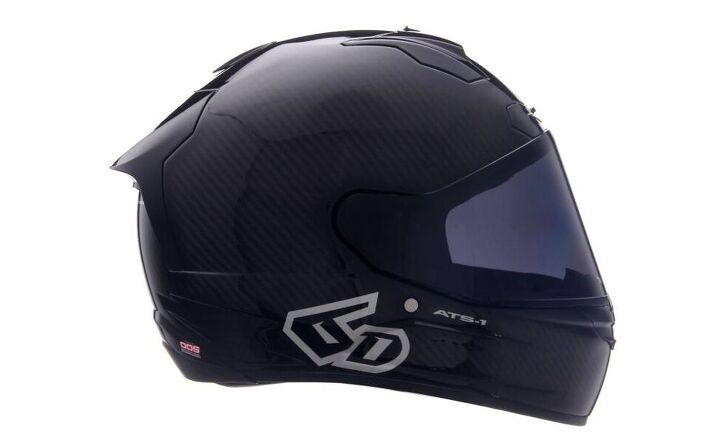
It sounds cliche, but 6D really did set out to reinvent the helmet. Maybe better known in the motocross and cycling worlds, the ATS-1R is the company’s latest street/track helmet offering, replacing the ATS-1. What makes the ATS-1R, and 6D in general, different from most other helmet companies is the use of what the company calls “Omni-Directional Suspension.”
It really is a completely different way of thinking about how helmets are constructed. As 6D literature explains:
6D’s revolutionary patented Omni-Directional Suspension (ODS) technology represents a fully active, in-helmet suspension and kinetic energy management system. Engineered to uncouple the helmet’s exterior shell from the inner EPS liner, the system effectively mitigates energy transfer to the head and brain of the rider during any given accident or impact event. The ODS system is comprised of 2 EPS liners separated by an array of elastomeric isolation dampers that allow the system to sheer and displace 3-dimensionally when subjected to impact.
Omni-Directional Suspension functions over a much broader range of energy demands, including LOW, MID and HIGH-Velocity impacts for both Angular and Linear accelerations when compared to other competing helmets, and helmet technologies.
ELASTOMERIC ISOLATION DAMPER
This damper is the heart and soul of 6D’s exclusive Omni-Directional Suspension technology. An array of dampers work in unison with the dual EPS liners to isolate impact energy from the brain. The elastic properties of the dampers, combined with their unique ‘hourglass’ shape provide a progressive spring rate that manages low and mid-velocity accelerations, while simultaneously allowing the inner EPS liner to displace and shear in 3-dimensional space. This omni-directional displacement capability of the EPS liners provides ‘six degrees of freedom’, which became the inspiration for our company name; ‘6D Helmets.’
Though we’ve never crashed in the ATS-1, we’ve come away impressed in our own experience with it. With the ATS-1R, 6D has made the helmet significantly lighter than its predecessor, while also adjusting the intermediate oval head profile to better fit more riders.
Arai Corsair-X

The flagship helmet in the Arai line, the Corsair-X is the same helmet you see all of Arai’s premier athletes wearing – from Jonathan Rea in World Superbike, to Maverick Viñales in MotoGP. With that being said, all Arai full-face helmets are made to the same safety standards. This means certifications like DOT and Snell are just the starting point. Each Arai incorporates the R75 shape, which as Arai explains, means the shell of the helmet has a continuous curve radius of at least 75mm. Arai says this means better dispersal of kinetic energy and minimizes “the potential for the helmet to catch on rough surfaces or obstacles, which may introduce unwanted rotational forces.” From a very basic construction standpoint, Arai helmets feature an EPS liner with a polycarbonate exterior shell.
The differences come by way of fit (long oval, round oval, or intermediate oval), ventilation, and slight aerodynamic changes. All Arai models allow for micro-adjustments by simply peeling away layers of the inner liner. Arai takes pride in the fact every single helmet it makes is handmade by skilled technicians who train for years, sometimes decades, to be the chosen few on the final assembly line. With the Corsair-X specifically, ventilation is everywhere compared to the other Arai models. Two channels run the length of the helmet along the top, with a third intake vent in between. Brow vents and a chin vent, with interior channels running along the inner liner, provide direct airflow to the wearer’s head. Lastly, the Arai faceshield may be less intuitive than the others listed to change, but once the procedure is mastered, it’s one of our favorites due to its smooth operation.
Furthermore, if you’re one of those people for whom only the finest will do, check out the Corsair-X RC, the raw carbon-fiber version, with a retail price of $3995.95. Oooo.
AGV Pista GP RR
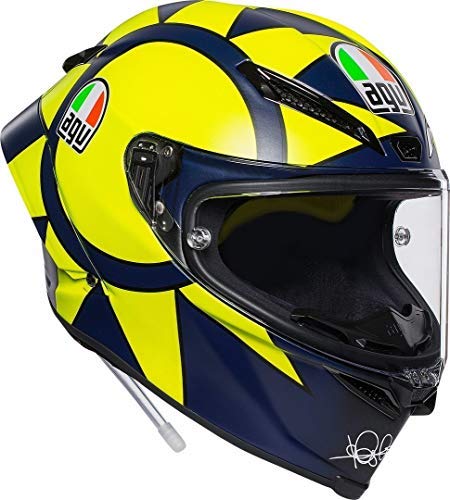
If you don’t know who he is yet, you will after your first trackday. Valentino Rossi is perhaps the biggest name in motorcycle racing, and the Soleluna graphic (sun and moon) has been his signature design for over 20 years now. The AGV Pista GP RR is AGV’s top-of-the-line track helmet, with a shell constructed entirely of carbon fiber (not just a carbon outer layer like some other companies) for ultimate weight savings. More importantly, each of its four available shell sizes receives its own dedicated EPS liner for supreme fit and comfort. There are seven sizes, from XS to XXL, including MS (medium-small) and ML (medium-large), the former getting its own dedicated shell while the latter shares its shell with the standard L helmet.
The Pista GP RR comes equipped with a long, dual-plane rear spoiler to help reduce turbulence behind the rider’s head. Computational Fluid Dynamic (CFD) simulation software was used in conjunction with wind-tunnel testing for aerodynamic purposes, not only to slice the cleanest hole through the air but also to help keep the rider’s head stable even while turning their head at high speed (our advice: Never look back). In the event of a crash, the spoiler is designed to snap off easily. Offering a 190º horizontal, and 85º vertical field of view, the eye port is huge and the 5mm thick visor is one of the thickest around.
Other various detail touches of the Pista GP RR include metal top vents, scooped and elongated chin vents to help draw in more air, a revised channeling system within the chin vents to disperse air across more of the face, a recessed visor closure system for smoother operation and to help prevent accidental openings in the event of a crash. Lastly, the Pista GP RR comes with an integrated hydration system.
Too much money? Take advantage of the fact that the GP RR is really a continuation of the theme AGV introduced with the GP R, which is being heavily discounted as the new RR takes over.
Bell Race Star Flex DLX
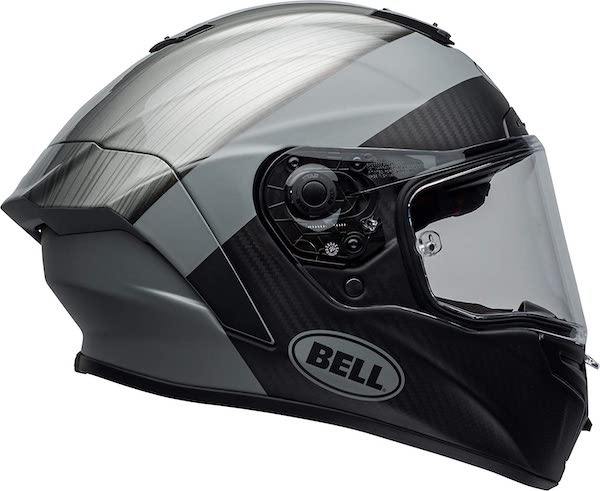
One of the most recognizable names in head protection, Bell is probably the name your parents remember when they got started in motorcycling. With the Bell Race Star Flex, you have the company’s premier track helmet. Utilizing a carbon fiber shell, the Flexx liner is a three-layer impact liner designed to manage energy from three potential impact scenarios: low, mid and high-speed. The Virus CoolJade liner and Magnefusion cheek pads ensure superior comfort and optimal fit.
The DLX indicates that a Panovision ProTint Photochromatic shield is included in the box, which automatically adjusts to light conditions to give you a perfect view of the finish line whether you’re racing at high noon or midnight.
Bell Star MIPS
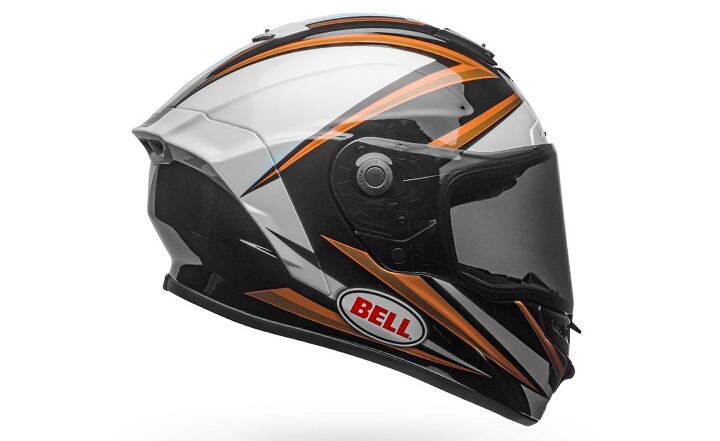
Very similar to the Race Star Flex, the Bell Star MIPS is an equally capable track helmet at a slightly lower price point. This is largely due to the TriMatrix composite shell (vs. carbon fiber). As the name would suggest, this version features MIPS technology to reduce rotational forces that can occur during certain impacts. Other features include pockets inside the liner to accommodate glasses, a Panovision shield with Class 1 optics, and a quick-drying, anti-microbial liner to keep you dry and funk free.
Just like with Bell’s Race Star Flex, Bell Star MIPSes marked DLX come with the photochromatic shield, which normally sells for around $140!
HJC RPHA 11 Pro
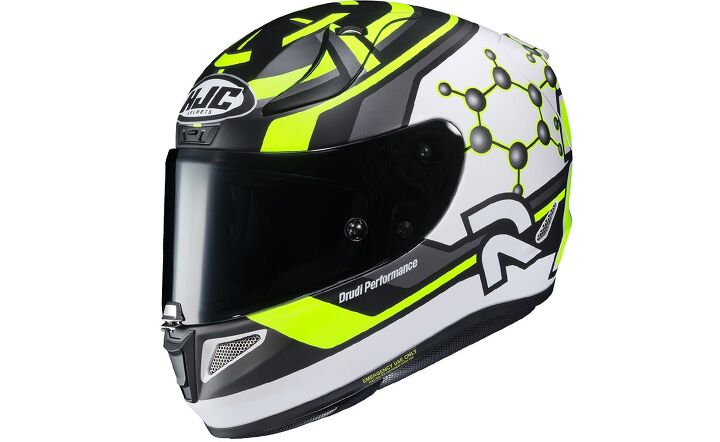
HJC has been producing premium helmets at midrange prices for decades now, in a crazy range of graphics including Marvel and DC Comics replicas. Its premier offering when it comes to track helmets, the RPHA 11 Pro, is shaped for intermediate oval heads and offers improved aerodynamics compared to the RPHA 10 it replaced, thanks to HJC’s inhouse wind tunnel. HJC’s lightweight Premium Integrated Matrix shell features a myriad of vents, including two top vents, a forehead vent, and a chin vent – and there’s now an even lighter and stronger RPHA 11 Carbon version availiable.
The shield is easily changed without tools, and the clasp at the front of the shield provides a positive lock when closed. A moisture-wicking, anti-microbial inner liner keeps you cool and fresh, and quick-release cheek pads make it easier for emergency personnel to remove the helmet. The eyeport is bigger than before, with a fog-free shield to keep your vision sharp at all times. The RPHA 11 Pro is DOT and ECE approved, and is available in XS-2XL sizes.
Schuberth R2 Carbon

The latest from Germany is the Schuberth R2 Carbon. Wind-tunel tested in the land of the autobahn, it features a 100% carbon fiber shell that’s aerodynamically tuned for maximum stability and minimum fatigue. Its comfy, quick-drying “ShinyTex” interior has a pre-installed speaker and microphone prepped for an SC1 communication system. The carbon shell is based on a round to intermediate oval headshape, and there’s an extra large antifog lens covering the eyeport to provide a wide field of vision in any riding position including full tuck.
Scorpion EXO-R1
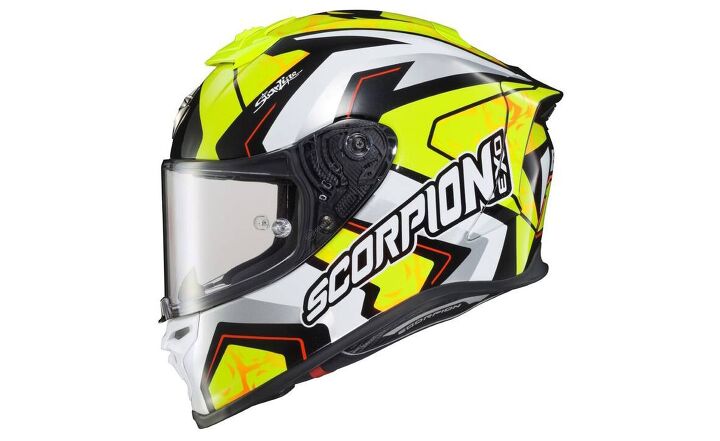
The Scorpion EXO-R1 is Scorpion’s new flagship track and racing helmet and is worn by the likes of Alvaro Bautista (whose replica graphic is shown above) and Fabio Quartararo. It’s a noteworthy helmet on this list because it offers many of the same features as the other helmets here, but for quite a bit less money. Scorpion’s new Ultra-TCT shell brings a unique fiberglass blend it promises will deliver high strength and low weight. Along with the aerodynamic shell, Scorpion’s Ellip-Tec shield technology is completely tool-less, and ratchets the shield against the eyeport for a secure, tight seal. Inside, a multi-density EPS liner features channels to funnel airflow from the huge intake vent at the top of the helmet. Four exhaust vents let air escape. A feature unique to the EXO-R1 is the Air-Fit system in the cheek pads. Basically a mini air bladder, it allows the wearer to inflate the cheek pads for optimum fit. As an added bonus and value, a dark smoke, Pinlock-ready shield is included with each helmet at the time of purchase.
Shark Race-R Pro
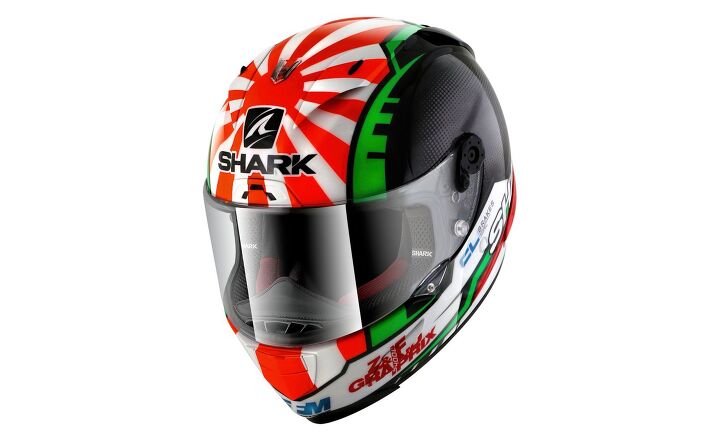
France’s entry into the premier helmet world, the Race-R Pro is a composite fiber helmet that, as Shark puts it, is reversed engineered to fit as close as possible to the human head. Aerodynamic testing with the top MotoGP and World Superbike riders have resulted in a helmet that remains steady even at speeds close to, and exceeding, 185 mph. There are four air scoops, seven extractors, three positions for the faceshield, and two different shell sizes. Unlike other shields here, the Shark shield is a varying density unit measuring 3mm at its thinnest point, up to 4.25mm at its thickest. Of course, it’s treated to an anti-scratch and anti-fog coating. The antibacterial liner is removable and washable, with interchangeable cheek pads offering customized fit. ECE 22.05 and DOT approved.
The top-o’-line Shark Race R Pro Carbon features, you guessed it, an even stronger and lighter carbon-fiber shell.
Shoei X-Fourteen
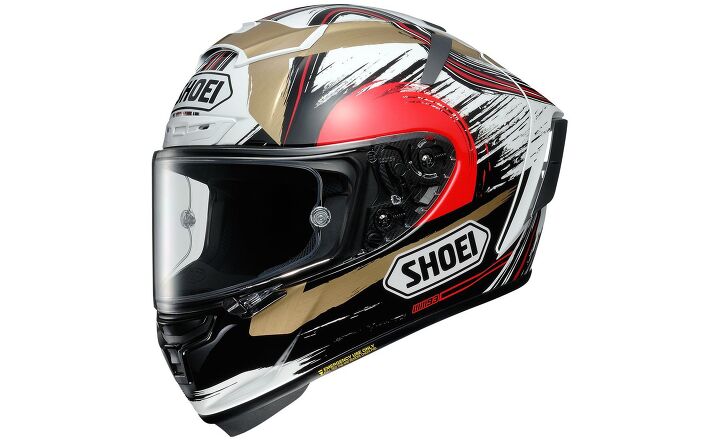
Shoei is Japan’s other luxury helmet brand, and its premier racing/track helmet, the X-Fourteen, is the same helmet the Marquez brothers – Alex and Marc – wear on their heads. As you can see from its shape, aerodynamic testing heavily shaped the 14’s form to provide optimum stability at high speeds. The same aero testing also influenced the ventilation channels of the helmet to help keep the rider’s head as cool as possible under the pressures of track riding. Four shell sizes are constructed from a six-ply matric of fiberglass composite materials, with a dual-layer, multi-density EPS liner offering multiple zones of protection in a crash. Like other helmets here, the X-Fourteen features emergency quick-release cheek pads. Speaking of the cheek pads, the moisture-wicking inner liner features a patent-pending rotating component that allows for a greater upper field of view when tucked. Optional sizes of each section of the center pad allow for a customizable fit.
Shoei RF-1400
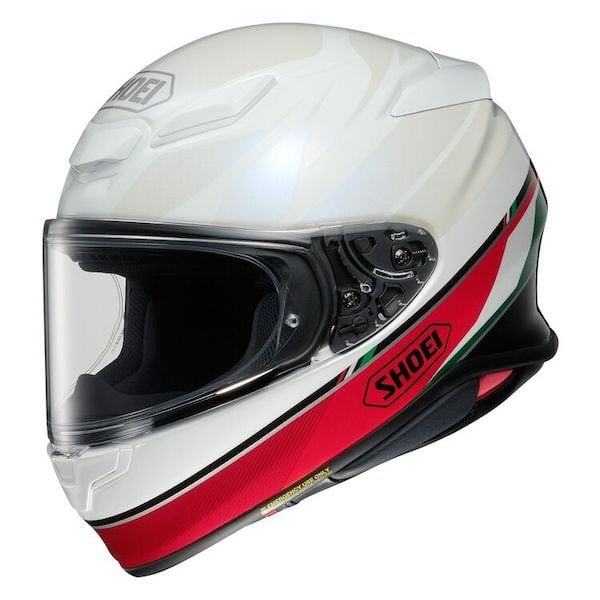
New for 2020, Shoei’s streetier but still racy RF-1400 carries on the tradition Shoei began in 1989 with the RF-200. Shoei’s in-house wind tunnel helped provide a 6% reduction in lift and a 4% reduction in drag when compared to its RF-1200 forebear, and vortex generators on the trailing edge of a new visor were borrowed from the X-Fourteen to help air flow even more quietly past the sides of the helmet. A new venting system also helps more air flow through it.
At 3.65 pounds, the RF-1400 is the lightest Snell-approved helmet in Shoei’s line. Its Multi-Ply Matrix AIM+ Shell construction utilizes a six-ply matrix of fiberglass with lightweight organic and high-performance fibers to create a strong-yet-elastic protective layer. Following the shell, Shoei’s Dual-Layer, Multi-Density EPS liner varies the foam density to absorb impacts while still allowing for channels that flow cooling air. Finally, the removable, washable, adjustable, and replaceable 3D Max-Dry Interior System II, is responsible for much of the RF-1400’s comfortable, premium fit.
Bargain hunter alert: the RF-1200 is still a benchmark helmet, and now deeply discounted…
FAQ
What to look for in motorcycle racing helmets?
The two primary things to look for in a racing helmet are:
A DOT, SNELL, ECE, or FIM safety rating. Proper fit.There’s a lot of controversy regarding the merit of different safety ratings, including DOT and SNELL, but those are topics for another discussion. If you plan on taking your motorcycle to the track, whether for racing or trackdays, one of these safety ratings on your helmet will be required (at least; check with the specific organization you plan to ride with for their requirements).
Even if you don’t plan on going to the track, safety ratings mean the helmet should provide a minimum level of safety should you land on your head. Decorative helmets (aka helmets without any sort of rating) are not tested to any standard and won’t protect you at all and are nothing more than, well, decoration.
A proper fit is important because no matter how many features and components a helmet has, if the helmet is uncomfortable on your head, you’re not going to wear it. The same goes for any piece of safety gear.
Are race car helmets the same as motorcycle race helmets?
No. There are several differences between car helmets and motorcycle helmets. For starters, motorcycle helmets tend to feature more robust ventilation channels since you’re exposed to the elements more so than even an open cockpit car. Eye ports on motorcycle helmets tend to be much larger as well. Some car helmets also have mounting points for neck restraints (HANS devices) that motorcycle helmets don’t.
A big difference between car helmets and motorcycle helmets is how each accounts for the dynamics that occur during a crash. In a car, the driver is strapped into the seat and there’s usually a roll bar and/or cage surrounding them. Because the driver’s position is basically fixed, their head/helmet will make impact with the same spot(s) continuously in a crash. So the helmet needs to be able to withstand those repeated hits (this is a big criterion in the SNELL test). Because a motorcycle rider gets ejected from the bike in a crash, it’s extremely unlikely the rider’s helmet will make impact with the same spot twice. If it does, it will be with a lot less force. The ECE rating takes into account rotational energy and dispersing impact forces as part of its certification process.
Additional Resources
Best Motorcycle Racing Tires You Can Also Use On The Street
Recent Updates: FAQ, Additional Resources, and Recent Updates added, removed out of stock helmet.
We are committed to finding, researching, and recommending the best products. We earn commissions from purchases you make using the retail links in our product reviews. Learn more about how this works.
Become a Motorcycle.com insider. Get the latest motorcycle news first by subscribing to our newsletter here.
The post Best Motorcycle Racing Helmets appeared first on Motorcycle.com.
Copyright
© Motorcycle.com

